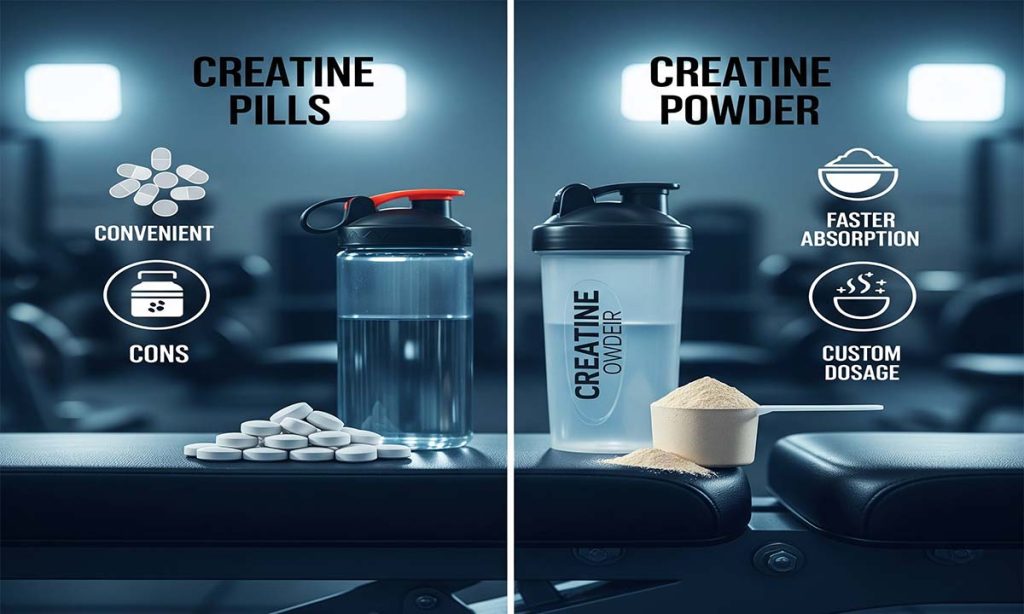Creatine is among the most researched sports supplements, widely used to boost strength, muscle mass, and athletic performance. It works by helping muscles regenerate the energy molecule ATP during short bursts of intense exercise. Creatine supplements come in various forms – most commonly powders and pills – and while both deliver creatine, they differ in key ways. This comprehensive guide will compare creatine pills vs powder, explain how each form works, and help you decide which is best for your routine. We cover absorption, dosage, convenience, and cost – and even advanced options like creatine monohydrate vs HCL – with expert sources and tips to guide your choice.

Table of Contents
What Is Creatine and How Does It Work?
Creatine is a natural compound (an amino acid derivative) that the body produces and stores in muscle tissue. It helps replenish ATP, the energy currency of cells, during high-intensity exercise. About 95% of the body’s creatine is stored in skeletal muscle, making it a critical fuel for lifting weights, sprinting, or any power sport. Research shows that creatine supplements (especially creatine monohydrate) improve muscle strength and performance in repeated bouts of exercise. In fact, a U.S. NIH report calls creatine “one of the most thoroughly studied and widely used dietary supplements to enhance exercise and sports performance”. When supplementing, people often do a loading phase (e.g. 20–25g daily for 5–7 days) then a maintenance dose (3–5g daily). This helps muscles fill their creatine stores faster, which can lead to quicker gains in strength and size creatine pills vs powder.
Creatine supplements are available as powders (creatine monohydrate or other types) and as capsules or tablets (often gelatin capsules). Despite the different packaging, the creatine compound is usually the same. Most creatine pills and powders contain micronized creatine monohydrate (about 88% creatine by weight). Other forms like creatine HCl (hydrochloride) are also sold, promising higher solubility. The choice between a pill or powder form is largely about how you take it, not about a different ingredient. In both forms, creatine goes to muscles to help produce energy and support muscle growth creatine pills vs powder.
Creatine Pills vs Powder: Key Differences
When comparing creatine powder vs pills, the main difference is form and delivery. Both contain creatine (usually monohydrate), but powders and pills have practical differences in absorption, dosing, convenience, and cost. Understanding these factors will help you decide which fits your lifestyle and goals: creatine pills vs powder.
- Mixing vs Swallowing: Powder is mixed into liquid; pills are swallowed like a vitamin. Powders require mixing (with water or juice), which can be messy or inconvenient if you’re on the go. Pills need no mixing – simply take with water – making them very portable and easy to dose anywhere.
- Absorption and Onset: Dissolving creatine powder in liquid may allow quicker absorption into the bloodstream. One source notes you might “notice creatine’s effects more quickly” from powder since it bypasses the digestion time of a capsule. Pills must be broken down by stomach acids before creatine is absorbed, so the effects can be slightly delayed. However, once creatine is in your muscles, the end result (ATP regeneration) is the same.
- Dosage Flexibility: Powder offers flexibility: you can easily adjust the dose (for example, 3g, 5g, or 10g at a time) by measuring scoops or teaspoons. Pills come in fixed dosages (e.g. each capsule has 1-2.5g creatine), so you need to swallow multiple pills to reach larger doses. This makes high-dose “loading” with pills less convenient creatine pills vs powder.
- Convenience and Portability: Pills are very convenient: no need for shaker bottles or mixing, and you can take them anywhere easily. This is great for travel or busy days. Powder often comes in large tubs (although travel-size sachets exist), and can be messy to measure and mix.
- Taste and Texture: Powders may have an unpleasant taste or grainy texture when mixed. Pills eliminate any taste issue entirely. If you’re sensitive to flavor or don’t like adding more shakes, pills win here.
- Stability and Shelf-Life: Bulk powder tends to be very stable; it can sit in a container for a long time without degrading. Pills often come in bottles that might protect from moisture, but individually they hold the same creatine content creatine pills vs powder.
- Cost: Powder is generally the more cost-effective form of creatine. Buying in bulk gives you a low price per gram. Pills cost more per serving because of the extra processing and packaging creatine pills vs powder.
Below, we break down the pros and cons of each form in more detail, with tips on choosing.
Creatine Powder (Advantages & Disadvantages)
Figure: A bag of unflavored creatine monohydrate powder, a popular and cost-effective supplement form. Creatine powder (usually unflavored micronized creatine monohydrate) is the traditional form of this supplement. It is highly customizable: you can measure a scoop (typically 3–5 grams) or use a portion of a teaspoon to match your target dose. Here are the main pros and cons: creatine pills vs powder.
- Pros of Creatine Powder:
- Fast Absorption: Powder dissolves in liquid, allowing creatine to enter your system quicker than a pill. This can mean a slightly faster onset of creatine’s effects after ingestion.
- Custom Dosing: You can easily increase or decrease the scoop size to get precisely the amount you need. This is helpful during a loading phase (e.g. taking 20g/day) where you might split the powder into multiple servings creatine pills vs powder.
- Cost-Effectiveness: Buying powder by the kilogram is usually much cheaper per gram of creatine. For example, one brand sells 5kg for about $130 (about $0.13/g) vs. $18.97 for 210 capsules.
- No Additives: Pure creatine powders often contain just creatine and maybe an anti-caking agent. You avoid gelatin or fillers that pills might have. This is good if you have allergies or want to avoid extra ingredients creatine pills vs powder.
- Cons of Creatine Powder:
- Mixing Required: You must stir or shake the powder into water, juice, or a protein shake before drinking. This takes extra time and equipment (cup, shaker). It’s also harder to carry around outside your home.
- Taste/Texture: Some users find unflavored creatine powder has a chalky texture or slight bitterness when mixed. If you dislike the taste or lumps, this could be unpleasant creatine pills vs powder.
- Gastrointestinal Effects: Because powder enters the stomach quickly, a few people report bloating or stomach upset (diarrhea, nausea) especially with large doses. These are generally mild and often tied to how much water is consumed with it creatine pills vs powder.
- Measuring Inconvenience: You need to carry a measuring scoop or scale to get the right dose each time. Accuracy depends on you using the scoop properly. It’s easy to scoop slightly too much or too little.
Creatine Pills (Advantages & Disadvantages)
Figure: A bottle of creatine monohydrate capsules. Creatine pills are convenient and pre-dosed but typically cost more than powder. Creatine pills or capsules contain the same creatine (usually monohydrate, sometimes HCL) in a tablet or gelatin capsule. Here’s how they stack up:
- Pros of Creatine Pills:
- Convenience: No mixing needed – just pop the pill with water. This is ideal when traveling, at work, or between activities. It’s also mess-free: no powder spills or clumping in a shaker.
- Precision: Each capsule contains a fixed amount of creatine (e.g. 1g or 2.5g per capsule). You always know exactly how much you’re taking, which helps ensure consistency each day.
- No Taste Issues: Pills are flavorless from your perspective, so there’s no unpleasant chalky taste or texture. You avoid the mouthfeel of powder creatine pills vs powder.
- Gentler on Stomach (sometimes): Because pills dissolve more slowly, they can reduce the chances of sudden gut irritation. Some users report fewer digestive side effects with pills.
- Portability: Pills can be carried in pockets or bags without fear of spilling, and you can take them discreetly anywhere creatine pills vs powder.
- Cons of Creatine Pills:
- More Expensive: Pills generally cost more per gram of creatine. The manufacturing and capsule materials add cost. For example, 420 capsules (420g) cost $27.97 vs. $23.97 for 500g powder on the same site.
- Fixed Dosage Inflexibility: You can only take whole capsules, so dosing is less flexible. If you need 5g, you must swallow multiple pills (e.g. two 2.5g capsules). During a 20g loading phase, you might need 8 or more capsules a day (which is inconvenient) creatine pills vs powder.
- Slower Absorption: Because the creatine must be released from the pill shell in your stomach, it absorbs a bit slower. This can slightly delay when creatine reaches the muscles, though long-term effectiveness is unchanged creatine pills vs powder.
- Swallowing Difficulty: Some people find many pills hard to swallow, or dislike taking pills at all. If you hate pills, they aren’t for you creatine pills vs powder.
Overall, choosing powder vs pills often comes down to lifestyle: Powder is best for cost savings and dosing flexibility if you don’t mind mixing; pills are best for convenience and portability if you’re willing to pay more.
Creatine Types: Monohydrate vs HCL (In Powder and Pill Form)
When choosing creatine, you may also encounter different chemical forms, mainly creatine monohydrate and creatine HCl (hydrochloride). Most research (and most products) use monohydrate, but HCl claims to offer benefits like better solubility. Importantly, both forms can come in powder or pill form creatine pills vs powder.
- Creatine Monohydrate: This is the classic form. It’s 88% creatine by weight. It’s very well-researched for increasing muscle strength and size. However, one water molecule is bound to each creatine molecule (hence “monohydrate”), which means muscles will pull in extra water. Many people get some water retention (“bloating”) during loading. Monohydrate is inexpensive and effective, but a small percentage of users dislike the bloating or have mild GI upset. Monohydrate powder is the most common; monohydrate pills/capsules typically contain just compressed or encapsulated monohydrate with minimal extras.
- Creatine HCl: Creatine hydrochloride is creatine bonded to a hydrochloride (salt) instead of water. This form is more soluble in liquid, so it mixes easily and may absorb with less stomach water. Manufacturers claim it works in smaller doses (e.g. 1-2g) compared to 5g of monohydrate, and that it causes little to no bloating. For example, one source notes HCl “requires smaller doses for similar effectiveness” and “takes bloating out of the equation”. Creatine HCl can be found in both powder and capsule forms. However, it’s usually more expensive, and research on its superiority is limited. For most people, monohydrate works great. HCl might be worth trying if you had issues with monohydrate (e.g. stomach upset) or prefer very low doses creatine pills vs powder.
In practice, pill vs powder differences are independent of creatine form. You can get monohydrate in powder or pill, and HCl in powder or pill. The pick of HCl vs monohydrate is another layer: HCl pills or powder might be more soluble and gentler, but at higher cost. Monohydrate (in either form) is cost-effective and proven effective.
Key Takeaway on HCL vs Monohydrate
If you encounter keywords like “creatine HCL vs powder” or “creatine monohydrate pills vs powder” online, remember: the pill vs powder debate is separate from HCL vs monohydrate. For example, you could have monohydrate in pill form (tablets) and in powder form (scoop), or HCl in capsules vs powder. The absorption and dosing factors apply similarly to both types. The difference is mainly chemical stability and water retention (HCL claims to reduce it). In either case, pills sacrifice a tiny bit of absorption speed for convenience, and powders do the opposite creatine pills vs powder.
How to Choose: Factors to Consider
Deciding between creatine in powder form vs pills involves balancing a few personal factors. Here are some considerations:
- Budget and Usage: If cost is a priority and you plan to use creatine for many months or years, powder is usually the most economical choice. Buying a big tub of powder can be half the price per gram compared to pills. If you take a daily maintenance dose (3–5g), you’ll go through less than 200g per year, which powder handles cheaply creatine pills vs powder.
- Convenience Needs: Are you at the gym frequently or traveling? Creatine pills win on portability. No shaker needed; toss a bottle in your bag or a few capsules in your pocket. If you only take creatine at home, powder’s inconvenience is less of an issue creatine pills vs powder.
- Dosing Accuracy: Do you care about micro-adjusting your dose? Powder lets you tailor the exact gram (useful for fine-tuning or loading phases). Pills come in fixed increments (e.g. 2.5g per capsule), which is simpler but less precise.
- Stomach Sensitivity: If you’ve experienced stomach upset from creatine powder (bloating, cramps), pills may be easier on your digestive tract since they dissolve slower. Also, HCl pills might help if water retention was a problem.
- Mixing Preferences: If you routinely drink shakes or juices, mixing creatine powder might fit naturally into your routine. If you dislike mixing or want no-fuss supplementation, pills are better.
- Brand and Quality: Independent testing is recommended for supplements in either form. Look for NSF or USP certifications. Some premium powders (e.g. Creapure®) are third-party tested. Similarly, check that pills use pure creatine without hidden fillers.
- Expert Recommendations: Sports nutrition experts emphasize consistency over form. The International Society of Sports Nutrition (ISSN) states creatine monohydrate is highly effective. They don’t declare a “better form” between pills vs powder; rather, they note that use of creatine (especially monohydrate) improves training performance and is safe. So, many pros/cons will guide you, but as long as you take it regularly, you get the benefits.
Practical Tips
- Loading vs Maintenance: If you want to saturate your muscles quickly, a loading phase of ~20g/day (in 4 doses of 5g) for 5–7 days is an option. With pills, that means ~8 pills (if 2.5g each) per day during loading, which may be burdensome. You could switch to powder for loading then back to pills for maintenance, or just take powder throughout. An alternative is just a smaller daily dose (3–5g) from the start, which works too but saturates muscles more slowly.
- Hydration: Creatine draws water into muscle cells. Whether you use powder or pills, drink extra water while supplementing to stay hydrated. This helps minimize any cramping or digestive issues.
- Timing: Time of day is not critical for creatine’s effectiveness. Studies show that taking it consistently (morning, post-workout, evening) yields similar results, as long as total daily intake is met. So choose whichever form fits your schedule.
- Stacking: If you already take protein shakes or pre-workout powders, adding creatine powder to those beverages can be convenient (just stir together). In contrast, you can also pair creatine pills with vitamin tablets or capsules for a supplement regimen.
- Listen to Your Body: Individual response can vary. Some people feel more bloated with powder, others feel more energetic. You might try both forms (a trial) to see which you prefer. There’s no harm in switching between them as long as you keep track of total intake. In fact, some athletes do powder at home and carry a few pills for travel days.
Comparison Summary
- Bioavailability: Both forms ultimately deliver the same creatine to your muscles. Powder is absorbed slightly faster, but the ultimate muscle uptake is similar with regular use.
- Ease of Use: Pills score high for on-the-go use and no-mess. Powder scores high if you want to mix into drinks and avoid swallowing many pills.
- Cost Efficiency: Powder is usually less expensive per serving. Pills cost more but require less prep time.
- Dosage Flexibility: Powder wins for easy adjustment and high-dose convenience (just add more scoops). Pills require multiple units for larger doses.
- Side Effects: Powder can cause more water retention and stomach issues for some people. Pills may mitigate those symptoms slightly (and HCL even more so).
- Taste/Texture: Powder can be unpleasant to some; pills have no taste issues.
- Ingredients: Powder generally only contains creatine (and maybe anti-caking agents). Pills may include binders, gelatin, or magnesium stearate. If you have allergies or dietary restrictions, check labels.
FAQs
Q: Are creatine pills and powder equally effective?
A: Yes. Whether you take creatine in pill or powder form, you’re ingesting the same active ingredient (typically creatine monohydrate). Studies show that as long as you hit the same total daily dose, both forms yield similar performance benefits. The difference lies in convenience, not the science.
Q: Which is better: creatine powder or pills?
A: Neither is universally “better” – it depends on your priorities. Creatine powder is better for flexibility and cost, while pills are better for convenience and portability. If you prefer shaking it into a drink and adjusting doses, go with powder. If you travel or dislike mixing, pills might suit you more.
Q: How many creatine pills equal one scoop of powder?
A: It depends on the pill’s creatine content. A typical powder scoop is 5 grams of monohydrate. Many creatine capsules contain around 1–2.5 grams each. For example, Optimum Nutrition capsules have 2.5g of creatine each. So 5g would be two capsules of that type. Some pills are smaller (e.g., 1g), requiring more tablets to reach 5g. Always check the label.
Q: Can I take creatine pills and powder together?
A: Yes, but it’s usually unnecessary. If you take both, just ensure you don’t exceed safe totals (around 5g/day maintenance). Combining forms won’t amplify benefits beyond taking one properly. It’s fine if, for instance, you use a few pills and add a scoop to a shake, but track your total grams.
Q: Which form is easier on the stomach?
A: Pills may be gentler for some people, because the creatine is released slowly. Creatine powder in large doses can sometimes cause bloating or cramps. If you notice stomach issues with powder, try pills or split your dose into smaller amounts with more water.
Q: What do Reddit or fitness forums say about pills vs powder?
A: Online fitness communities like Reddit often conclude that it’s a matter of personal preference and lifestyle. The consensus is that “creatine is creatine” – the benefits are the same, but powder costs less and pills are more convenient. In other words, users advise choosing the form that you’ll actually stick with consistently.
Q: Is one form better for beginners?
A: For beginners, starting with powder is common because you can easily adjust your dose. Also, beginners often use the standard loading protocol (20g/day) and doing that with pills means a lot of capsules to swallow. So powder may be simpler initially. However, if you value convenience from day one, pills can work too – just take enough (usually 3–5g/day after loading).
Q: How should I take creatine for best results?
A: Take creatine consistently every day. Timing (morning vs post-workout) is less critical than being regular. During a loading week, split the dose across meals. After that, 3–5g once daily is enough. Mix powder into water or juice and drink it, or swallow your capsules. Always drink plenty of water with any supplement.
Q: Any other tips?
A: Store your creatine in a cool, dry place. Keep a daily supplement log if helpful (especially if you use both pills and powder). And choose a reputable brand. Look for labels that list exactly “creatine monohydrate” or “creatine HCl” without vague proprietary blends. Some trusted manufacturers have third-party testing, which adds confidence.
Final Thoughts
Deciding between creatine pills vs powder comes down to convenience vs cost and flexibility. Powder generally wins on affordability and dosage control, while pills win on portability and ease of use. Both forms, however, are effective at boosting muscle creatine stores and improving high-intensity exercise performance. Whether your fitness journey favors a quick scoop or a quick swallow, the most important thing is to take creatine consistently at the right dose.
Ultimately, the best creatine is the one you will take regularly. If you’re still unsure, you might try a small amount of each form. Many athletes actually do both: mixing powder with their post-workout shake at home and taking pills on travel days.
Remember to stay hydrated and follow recommended dosing. With either powder or pills, creatine supplementation is a safe, effective way to enhance muscle strength and workout gains.
Have you tried creatine in powder or pill form? Share your experience or questions in the comments below! If you found this guide helpful, share it on social media so others can benefit.




